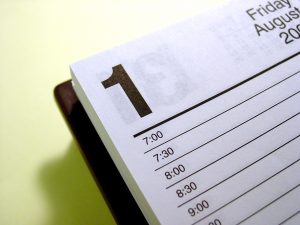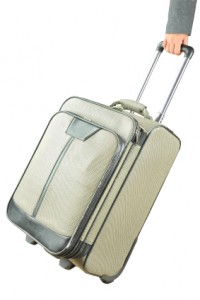 Do you struggle trying to accomplish everything you want to get done in a week? Are you always asking yourself “where does the time go?” Are you always running late for appointments? Instead of trying to keep it all organized in your head, start a time management system for yourself by using a calendar (digital or paper, whatever your preference), a Day-Timer, or even an excel spreadsheet will work.
Do you struggle trying to accomplish everything you want to get done in a week? Are you always asking yourself “where does the time go?” Are you always running late for appointments? Instead of trying to keep it all organized in your head, start a time management system for yourself by using a calendar (digital or paper, whatever your preference), a Day-Timer, or even an excel spreadsheet will work.
Remember school schedules? The week is scheduled by the day, classes with start and end times are filled in first and the remaining time is what you have left for the week. Start with your non-flexible commitments, such as; work, and then plan the other activities or tasks by the days and times available in the space you have left. Block out the amount of time each commitment, task, or activity will take and include travel time if necessary. This will visually put your time available to accomplish your tasks for the week “at a glance” and into perspective. This is imperative for getting a handle on your time management schedule. If there are overlapping commitments and a shortage of time available to get everything accomplished, you know it’s time to reorganize your week.
Keep in mind, you do need to sleep, so only schedule your time during your realistic waking hours. Each day follow your day’s schedule of events to know where you have to be and when. Then when emergencies crop up and they will, you will have a much better handle on where to reschedule the lessor priorities.
Don’t overbook yourself. Be realistic, allow for travel time and most importantly, don’t forget to allow for “down-time”!
Click on the title above to learn more about the featured author.
 Eventually, the time may come when you feel like the amount of ‘stuff’ you have surrounded yourself with in your home is beginning to have a negative effect on you. For years, those items may have brought you comfort. However, now you may feel claustrophobic in your own personal space. When those feelings begin to occur, and you want to make a change but do not know how, that is usually when it’s time to call a professional organizer.
Eventually, the time may come when you feel like the amount of ‘stuff’ you have surrounded yourself with in your home is beginning to have a negative effect on you. For years, those items may have brought you comfort. However, now you may feel claustrophobic in your own personal space. When those feelings begin to occur, and you want to make a change but do not know how, that is usually when it’s time to call a professional organizer.
The most common description I hear when a potential organizing client calls me is; “I am so overwhelmed.” Upon arriving at the home, I may also hear “I’m so embarrassed,” or “Have you ever seen anything this bad before?” Let me put your mind to rest. As an organizer, I am not there to judge. I am there to help. Professional organizers want to help or we would not be in this profession.
It’s not always easy to clear away things you’ve amassed in your home, whether they are collectibles or household items that just seem to keep accumulating. When sorting through excess things in your home, whether you consider those items clutter or treasured keepsakes, please understand that organizing is a process that takes time. It involves purging, separating, and categorizing every individual piece to achieve the desired results.
Others that are not experiencing the same emotional issues as you when it comes to de-cluttering may have no empathy for your situation. They tell you to “toss it,” or “just throw that stuff out”. Letting go of items can be a daunting task and working with an understanding expert is invaluable whether you wish to accomplish an organized desk, office, closet, room or your entire home.
Your professional organizer will not only facilitate this process, but bring you a sense of calm and understanding as you work through this course of action together. Please don’t misunderstand, it is important for you, as the owner of the possessions, to be a part of this decision making process. Otherwise, you may only be relocating items from one space to another.
Professional organizers can be likened to life coaches, who are defined as somebody who provides advice and support to people who wish to improve their lives, helping them to make decisions, solve problems, and achieve goals. I often hear “I know I should be able to do this on my own, but I can’t seem to make myself do this without you.” Guess what, that’s ok. That comfort, guidance and understanding is much of what we, as professional organizers, bring to you. Of course, we also have the obvious capability to assess and accelerate your project, and then bring it all together with our uncanny sense of space planning to give you a tidy new space.
And isn’t that what you wanted all along; an organized space, free of clutter, that you can find comfort in, and be proud to call your own?
Does the thought of organizing your desktop bring music to your ears for the anticipation of the neat and orderly results of this accomplishment or does it bring painful groans of displeasure wondering how you will accomplish this seemingly impossible task for your desk?
As is the case with many tasks and projects, if we break it down into smaller parts then it’s not so overwhelming. Of course, there is always the super easy way out and that’s the complete one swipe and into the box removal. Quick, easy, and painless but I don’t think that’s really what you want to do. Especially not on National Clean Off Your Desk Day! So let’s take a look at a more organized and orderly approach.
1. Assess
First, take stock of what is on your desk. Consider what items you need to address such as: paper, files, and office supplies — along with any random items on your desk.
2. Store
Next, decide how to store these items that are currently on top of your desk.
3. Remove
Finally, remove miscellaneous items that have no relevancy to your work area. You may even find some items that are trash which is a super quick removal. Here is where the one swipe and into a box is a handy option. Make sure to return all of those random items such as books, magazines, empty coffee cups, etc. to their designated homes.
There you have it: 3 easy ways to tidy up your desktop! Optimize your productivity while at your desk by using 3 simple steps — Assess, Store, and Remove — to keep your desktop neat and organized.
 When trying to save time and money at the grocery store, the first step is to start with your menu plan. Plan your meals by making a weekly menu. Of course you can also do bi-monthly or monthly if you feel so inspired, but if this is a new process start with a week until you get comfortable with this idea.
When trying to save time and money at the grocery store, the first step is to start with your menu plan. Plan your meals by making a weekly menu. Of course you can also do bi-monthly or monthly if you feel so inspired, but if this is a new process start with a week until you get comfortable with this idea.
For each day of the week, plan what your meals will be including breakfast, lunch, snacks, and beverages. Now check to see if you have written any specialty recipes down that may require additional ingredients such as spices, etc. Start making your grocery list based upon your menu.
Check your pantry and make sure you have all of the ingredients or food items you need to accomplish your meal plan for the week. If you do not, write them down on your grocery list. This way of planning will keep you organized so preparing and cooking your meals will go off without a hitch. Being organized will help to prevent the need to run back to the store for forgotten items or ingredients.
Keep a running grocery list during the week for any supplies that run out or are getting low. Add these items to your grocery list. This is an especially helpful household task for when you have multiple family members. If you used the last of something, put it on the list, do not let the next person needing that item be the one to find out it’s not there when they need it. A detailed grocery list helps you from forgetting items that you may need.
Do you use coupons? If not skip this paragraph. If so, keep your coupons in a file or a convenient place such as your pocketbook. Organize the coupons in the same manner you organized your list; by the order of where those items will be found in the aisles. Check that you are purchasing the exact brand, item, size requirement, etc. from that coupon as you are selecting that item. This will save you time and embarrassment at the checkout counter from choosing an incorrect item. Also check for expiration dates on your coupons.
Now if you want to save time at the grocery store take this list one step further and organize the list based upon the grocery store aisles where you do your shopping. This way you are able to cross items off the list as you go up and down the aisles. This will help you from going back and forth through the aisles if you skip something. It also helps from forgetting items.
To recap:
Planning your menu and grocery list in an organized manner will not only help you become an organized shopper, it will save you time and money as well. Happy Shopping!
 There are a few basic components of your vacation you need to consider before you select certain articles and start to pack. If you are traveling by air, be aware of your carrier’s baggage restrictions. This is the time to be efficient with your space! Below are my 20 tips to help you pack like a pro:
There are a few basic components of your vacation you need to consider before you select certain articles and start to pack. If you are traveling by air, be aware of your carrier’s baggage restrictions. This is the time to be efficient with your space! Below are my 20 tips to help you pack like a pro:
Now zip your suitcase and go! Bon Voyage!
 Do you struggle trying to accomplish everything you want to get done in a week? Are you always asking yourself “where does the time go?” Are you always running late for appointments? Instead of trying to keep it all organized in your head, start a time management system for yourself by using a calendar (digital or paper, whatever your preference), a Day-Timer, or even an excel spreadsheet will work.
Do you struggle trying to accomplish everything you want to get done in a week? Are you always asking yourself “where does the time go?” Are you always running late for appointments? Instead of trying to keep it all organized in your head, start a time management system for yourself by using a calendar (digital or paper, whatever your preference), a Day-Timer, or even an excel spreadsheet will work.
Remember school schedules? The week is scheduled by the day, classes with start and end times are filled in first and the remaining time is what you have left for the week. Start with your non-flexible commitments, such as; work, and then plan the other activities or tasks by the days and times available in the space you have left. Block out the amount of time each commitment, task, or activity will take and include travel time if necessary. This will visually put your time available to accomplish your tasks for the week “at a glance” and into perspective. This is imperative for getting a handle on your time management schedule. If there are overlapping commitments and a shortage of time available to get everything accomplished, you know it’s time to reorganize your week.
Keep in mind, you do need to sleep, so only schedule your time during your realistic waking hours. Each day follow your day’s schedule of events to know where you have to be and when. Then when emergencies crop up and they will, you will have a much better handle on where to reschedule the lessor priorities.
Don’t overbook yourself. Be realistic, allow for travel time and most importantly don’t forget to allow for “down-time”!